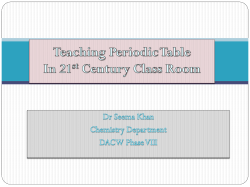
Yongan Yang
D EPART MEN T OF CHE MI S T RY SEMINAR SERIES SPRING 2015 Nanomaterials for Electrochemical Energy Conversion and Storage Yongan Yang Assistant Professor Department of Chemistry, Colorado School of Mines Electrochemical energy conversion and storage is important for developing an energy-sustainable society. Our group focuses on (electro) catalysis and rechargeable batteries. Inspired by the power of synthetic chemistry and materials chemistry, all our activities start with inorganic synthesis, materials characterization, and application exploration. This talk will consist of two topics: noble metal nanoparticles for (electro)catalysis and earthabundant elements for lithium ion batteries (LIBs). Nobel metal nanoparticles, a group of important catalysts for many applications, are typically synthesized via top-down or bottom-up methods. Few syntheses integrate the advantages of both strategies. Recently, we have developed such an unconventional method. The method is entitled alternating voltage induced electrochemical synthesis (AVIES). Highly dispersed nanoparticles of noble metals (Pd, Au, Pt, and Ag) have been synthesized. We will discuss the synthesis, characterization, mechanism, and (electro) catalytitic performance of a few noble metals. LIBs, the most advanced rechargeable batteries, are currently ubiquitous in portable devices and will be popular in large-scale applications (such as electric vehicles) in the future. Our interests lie in three types of electrode materials made from earth-abundant elements, including silicon anode, iron pyrite cathode, and sulfur cathode. A common challenge for them is their poor cyclability originating from the volume-fluctuation induced electrode damage during the lithiation/delithiation cycles. For silicon, our strategy is to start with the fullylithiated state lithium silicides to accommodate the volume fluctuation. For iron pyrite, our strategy is to encapsulate synthetic nanoparticles in elastic matrix. For sulfur, our strategy is to obtain synthetic lithium sulfide from cleaning hydrogen sulfide, a widely-exist industrial chemical waste. Our recent progress in materials synthesis, characterization, and electrode performance for these systems will be presented. Friday, April 03 12:00–1:00PM SI 2001 D EPART MEN T OF SEMINAR SERIES SPRING 2015 Simulation insights into designer self-assembled materials M. Scott Shell Associate Professor Department of Chemical Engineering We discuss the development and application of novel molecular simulation methods to understand bio-inspired self-assembly principles in nanostructured materials. In the first part of the talk, we examine self-assembly as route to chiral materials made from achiral molecules. We show that a surprisingly simple shaped-based mechanism can drive achiral particles into chiral assemblies. The mechanism quantitatively explains recent experimental results reporting emergent chirality in the two-dimensional hard triangle system, and it predicts other shapes that might exhibit similar behavior. Such results suggest a powerful way to design materials with unique chiral responsive behavior, and may also suggest a way that chiral structures might emerge in nature. In the second part of the talk, we consider newly engineered peptides that hold promise as controllable, environmentally benign alternatives for nanoscale materials and scaffolds. Despite experimental advances in this area, it remains an immense challenge to predict even basic selfassembly properties from a theoretical perspective. We show how novel multiscale simulation techniques can elucidate the delicate balance of assembly driving forces and modulate unique phase behavior in these systems. Friday, April 10 12:00–1:00PM SI 2001 D EPART MEN T OF SEMINAR SERIES SPRING 2015 Interfacial Chemistry of NanoparticleCharge Transfer Shaowei Chen Professor Department of Chemistry & Biochemistry, University of California Santa Cruz Organically capped metal nanoparticles represent a unique class of functional nanomaterials that have attracted a great deal of attention in diverse areas of research. With the organic-inorganic composite structures, the nanoparticle structures and properties have long been known to be manipulated by both the organic capping ligands and the metal cores. Recently we have shown that metal-ligand interfacial bonding interactions may also play a significant role in controlling the nanoparticle optical and electronic properties. In this presentation, we will describe several examples where a range of metal-ligand interfacial bonds may be readily prepared and discuss their impacts on nanoparticle electron-transfer chemistry and the implication in the electrocatalytic performance of nanoparticle catalysts in fuel cell electrochemistry. Wednesday, April 15 12:00–1:00PM KC 212
© Copyright 2025





















